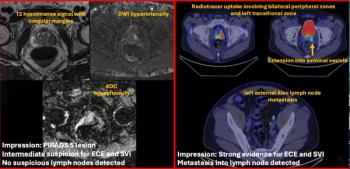Study: CCTA-Derived Fractional Flow Reserve Can Predict MI and Mortality Risks in Patients with Stable Angina
Abnormal findings on coronary computed tomography angiography-derived fractional flow reserve (CCTA-FFR) are associated with 3.2-fold higher risks of all-cause death or spontaneous myocardial infarction (MI) in patients with new-onset stable angina pectoris and coronary stenosis, according to newly published research.
New research suggests that patients with new-onset stable angina pectoris and coronary stenosis have over triple the risk of all-cause death or spontaneous myocardial infarction (MI) when there are abnormal findings on coronary computed tomography angiography-derived fractional flow reserve (CCTA-FFR) testing.
For the prospective study, recently published in
The researchers found that study participants with abnormal CCTA-FFR findings had a 3.2-fold higher risk of all-cause death and spontaneous MI, and an 8.8-fold higher risk of cardiovascular death and spontaneous MI in comparison to those with normal CCTA-FFR findings.
“(Study) participants with new-onset stable angina pectoris who had normal (CCTA-FFR) values showed a reduced risk of adverse outcomes at 3-year follow-up compared with those with abnormal (CCTA-FFR) test results,” wrote lead study author Kristian T. Madsen, M.D., who is affiliated with the Department of Cardiology at the University Hospital of Southern Denmark in Esbjerg, Denmark, and colleagues.
For study participants with high coronary artery calcium (CAC) scores (>400), the researchers found that normal CCTA-FFR values were associated with a 2.2 percent rate of all-cause death or spontaneous MI in comparison to a 4.1-fold risk in participants with abnormal CCTA-FFR values. The study authors also found a 12-fold increased risk for cardiovascular death or spontaneous MI in study participants with abnormal CCTA-FFR values in contrast to an 0.5 percent rate associated with normal CCTA-FFR values.
“Our study provides evidence for the prognostic potential of coronary CTA-derived FFR in patients with high CAC scores. Specifically, in participants with CAC scores of at least 400, those with normal coronary CTA-derived FFR results had a lower frequency of adverse cardiac events at (the three-year follow-up) … compared with those with abnormal coronary CTA-derived FFR results … ,” noted Madsen and colleagues.
In an
“This result further promotes the use of this important and convenient technique for triage and treatment of patients with CAD with stable disease,” wrote Dr. Sinitsyn, the head of the Radiology Department at the University Hospital of Moscow Lomonosov State University in Russia, and president of the Russian Society of Radiology.
In regard to study limitations, the study authors acknowledged a lack of data on the duration of medication treatment in the study cohort and that inadequate CTA image quality in a small percentage of cases prevented analysis of CCTA-FFR for the entire cohort. Madsen and colleagues also noted potential selection bias as the research was a sub-study of a larger non-randomized study cohort in which local physician discretion factored into clinical management decisions.
Newsletter
Stay at the forefront of radiology with the Diagnostic Imaging newsletter, delivering the latest news, clinical insights, and imaging advancements for today’s radiologists.





























